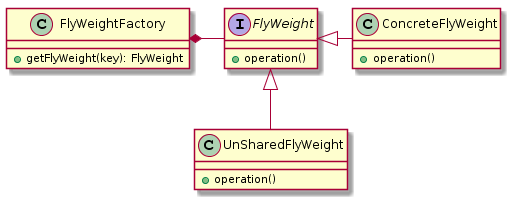享元模式(Flyweight Pattern)
定义: 享元模式(Flyweight Pattern),又称轻量级模式(这也是其英文名为FlyWeight的原因),通过共享技术有效地实现了大量细粒度对象的复用。
类型: 结构型模式
UML
1 2 3 4 5 6 7 8 9 10 11 12 13 14 15 16 17 18 19 20 21 22 23 @startuml interface FlyWeight{ + operation() } class ConcreteFlyWeight{ + operation() } class UnSharedFlyWeight{ + operation() } class FlyWeightFactory{ + getFlyWeight(key): FlyWeight } FlyWeightFactory *- FlyWeight FlyWeight <|- ConcreteFlyWeight FlyWeight <|-- UnSharedFlyWeight @enduml
角色说明
FlyWeight: 抽象接口或者抽象享元类,定义共享接口ConcreteFlyWeight: 具体享元类(或称为单纯享元模式)UnSharedFlyWeight: 非共享享元实现类(或称为复合享元模式)FlyWeightFactory: 享元工厂类,控制实例的创建和共享
在Java语言中,String类型就是使用了享元模式。
String对象是final类型,对象一旦创建就不可改变。在Java中字符串常量都是存储在常量池中的,Java会确保一个字符串常量在常量池中只有一个拷贝。
在Integer.valueOf()中有一个IntegerCache [-128, 127] ,同理Long中也一样
1 2 System.out.println(Integer.valueOf(122 )==Integer.valueOf(122 )); System.out.println(Integer.valueOf(128 )==Integer.valueOf(128 ));
内部状态和外部状态
内部状态(Internal State): 是存储在享元对象内部,一般在构造时确定或通过setter设置,并且不会随环境改变而改变的状态,因此内部状态可以共享外部状态(External State): 是随环境改变而改变、不可以共享的状态。外部状态在需要使用时通过客户端传入享元对象。外部状态必须由客户端保存
单纯享元模式 在单纯享元模式中,所有的享元对象都是可以共享的。
复合享元模式 复合享元对象是由单纯享元对象通过复合而成的,因此可以提供add()这样的聚集管理方法。
由于一个复合享元对象具有不同的聚集元素,这些聚集元素在复合享元对象被创建之后加入,这本身就意味着复合享元对象的状态是会改变的,因此复合享元对象是不能共享的。
复合享元角色实现了抽象享元角色所规定的接口,也就是operation()方法,这个方法有一个参数,代表复合享元对象的外蕴状态。
一个复合 享元对象的所有单纯享元对象元素的外蕴状态都是与复合享元对象的外蕴状态相等的;而一个复合享元对象所含有的单纯享元对象的内蕴状态一般是不相等的,不然 就没有使用价值了。
享元模式示例一 FlyWeight
1 2 3 public interface FlyWeight void operation (String external) }
ConcreteFlyWeight/UnSharedFlyWeight
1 2 3 4 5 6 7 8 9 10 11 12 13 14 15 16 17 18 19 20 21 22 23 24 25 26 27 28 29 30 31 32 33 34 35 36 37 38 39 40 41 42 43 44 45 46 47 public class ConcreteFlyWeight implements FlyWeight private final String name; public ConcreteFlyWeight (String name) this .name = name; } @Override public void operation ( String external) System.out.println("ConcreteFlyWeight Object = " + this ); System.out.println("Internal Status = " + name); System.out.println("External Status = " + external); } } public class UnSharedFlyWeight implements FlyWeight private static final WeakHashMap<String, FlyWeight> CACHE = new WeakHashMap<>(); public void add (String internal,FlyWeight flyWeight) synchronized (CACHE){ CACHE.put(internal, flyWeight); } } @Override public void operation (final String external) synchronized (CACHE){ CACHE.values().forEach((flyWeight)-> flyWeight.operation(external)); } } public static int UnSharedFlyWeightInCache () synchronized (CACHE){ return CACHE.size(); } } }
FlyWeightFactory
1 2 3 4 5 6 7 8 9 10 11 12 13 14 15 16 17 18 19 20 21 22 23 24 25 26 27 28 29 30 31 32 33 34 35 public final class FlyWeightFactory private static Map<String, FlyWeight> pool = new ConcurrentHashMap<>(16 ); private FlyWeightFactory () } public static FlyWeight getCompositeFlyweight (List<String> list) UnSharedFlyWeight unSharedFlyWeight = new UnSharedFlyWeight(); for (final String internal:list){ unSharedFlyWeight.add(internal,getFlyWeight(internal)); } return unSharedFlyWeight; } public static FlyWeight getFlyWeight (String internal) return pool.computeIfAbsent(internal, ConcreteFlyWeight::new ); } public static int poolSize () return pool.size(); } }
Client
1 2 3 4 5 6 7 8 9 10 11 12 13 14 15 16 17 18 19 20 21 22 23 24 25 26 public class Client public static void main (String[] args) List<String> internals = Arrays.asList("test1" , "test2" ); final FlyWeight concreteFlyWeight1 = FlyWeightFactory.getFlyWeight(internals.get(0 )); concreteFlyWeight1.operation("concreteFlyWeight1" ); final FlyWeight concreteFlyWeight2 = FlyWeightFactory.getFlyWeight(internals.get(0 )); concreteFlyWeight2.operation("concreteFlyWeight2" ); System.out.println(concreteFlyWeight1 == concreteFlyWeight2); System.out.println(FlyWeightFactory.poolSize()); System.out.println("\n\n\n" ); final FlyWeight compositeFlyweight1 = FlyWeightFactory.getCompositeFlyweight(internals); final FlyWeight compositeFlyweight2 = FlyWeightFactory.getCompositeFlyweight(internals); compositeFlyweight1.operation("compositeFlyweight1" ); compositeFlyweight2.operation("compositeFlyweight2" ); System.out.println(compositeFlyweight1); System.out.println(compositeFlyweight2); System.out.println(compositeFlyweight1 == compositeFlyweight2); System.out.println(UnSharedFlyWeight.UnSharedFlyWeightInCache()); } }
享元模式示例二 模拟一家咖啡馆正常经营的情况
咖啡口味
1 2 3 4 5 6 7 8 9 10 11 12 13 14 15 16 17 18 19 20 21 22 23 24 25 26 27 28 29 30 31 32 33 34 35 36 37 38 39 public class CoffeeFlavour private final String name; private static final WeakHashMap<String, CoffeeFlavour> CACHE = new WeakHashMap<>(); private CoffeeFlavour (String name) this .name = name; } @Override public String toString () return name; } public static CoffeeFlavour intern (String name) synchronized (CACHE){ return CACHE.computeIfAbsent(name, CoffeeFlavour::new ); } } public static int flavoursInCache () synchronized (CACHE){ return CACHE.size(); } } }
订单处理类
1 2 3 4 5 6 7 8 9 10 11 12 13 14 15 16 17 18 @FunctionalInterface public interface Order void serve () static Order of (String flavourName,int taleNumber) CoffeeFlavour flavour = CoffeeFlavour.intern(flavourName); return () -> System.out.println("Serving " + flavour + " to table " + taleNumber); } }
咖啡馆
1 2 3 4 5 6 7 8 9 10 11 12 13 14 15 16 17 18 19 public class CoffeeShop private final ArrayList<Order> orders = new ArrayList<>(); public void takeOrder (String flavour,int tableNumber) orders.add(Order.of(flavour, tableNumber)); } public void service () orders.forEach(Order::serve); } }
客户端
1 2 3 4 5 6 7 8 9 10 11 12 13 14 15 16 17 18 19 20 21 22 23 24 25 26 public class FlyWeightExample public static void main (String[] args) final CoffeeShop shop = new CoffeeShop(); shop.takeOrder("Cappuccino" , 2 ); shop.takeOrder("Frappe" , 1 ); shop.takeOrder("Espresso" , 1 ); shop.takeOrder("Frappe" , 897 ); shop.takeOrder("Cappuccino" , 97 ); shop.takeOrder("Frappe" , 3 ); shop.takeOrder("Espresso" , 3 ); shop.takeOrder("Cappuccino" , 3 ); shop.takeOrder("Espresso" , 96 ); shop.takeOrder("Frappe" , 552 ); shop.takeOrder("Cappuccino" , 121 ); shop.takeOrder("Espresso" , 121 ); shop.service(); System.out.println("CoffeeFlavor objects in cache: " + CoffeeFlavour.flavoursInCache()); } }
输出结果为:
1 2 3 4 5 6 7 8 9 10 11 12 13 Serving Cappuccino to table 2 Serving Frappe to table 1 Serving Espresso to table 1 Serving Frappe to table 897 Serving Cappuccino to table 97 Serving Frappe to table 3 Serving Espresso to table 3 Serving Cappuccino to table 3 Serving Espresso to table 96 Serving Frappe to table 552 Serving Cappuccino to table 121 Serving Espresso to table 121 CoffeeFlavor objects in cache: 3
享元模式的优缺点 优点:
享元模式的外部状态相对独立,使得对象可以在不同的环境中被复用(共享对象可以适应不同的外部环境)
享元模式可共享相同或相似的细粒度对象,从而减少了内存消耗,同时降低了对象创建与垃圾回收的开销
缺点:
外部状态由客户端保存,共享对象读取外部状态的开销可能比较大
享元模式要求将内部状态与外部状态分离,这使得程序的逻辑复杂化,同时也增加了状态维护成本

